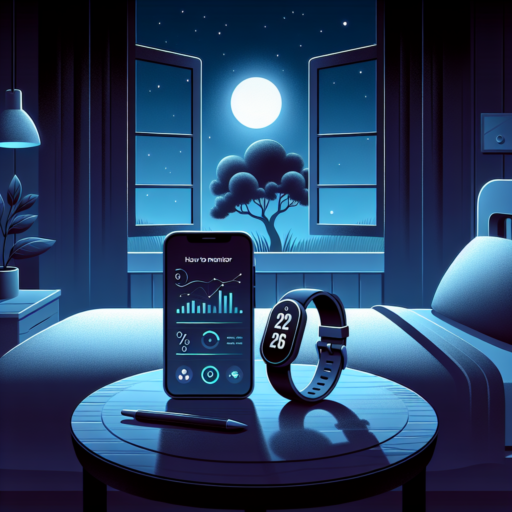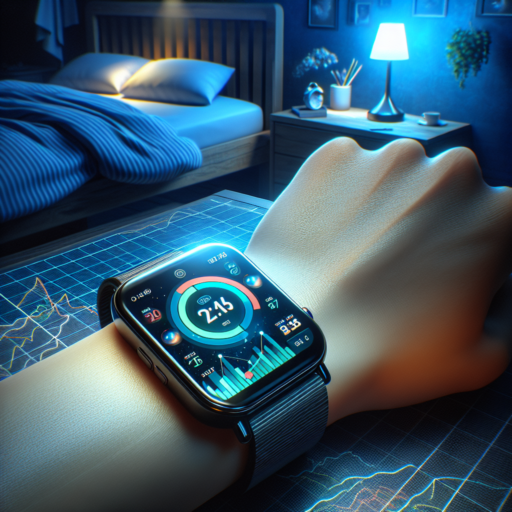Understanding Fitbit’s Sleep Tracking Capabilities
Fitbit has become a leading name in the world of wearable fitness technology, with its sleep tracking feature standing out as a particularly popular function. This capability not only monitors the duration of sleep but also delves into the quality, providing users with insights into their sleep patterns. By understanding the depth and quality of sleep through various stages, individuals can make informed adjustments to their lifestyle for better sleep health.
How Fitbit Monitors Sleep Stages
At the heart of Fitbit’s sleep tracking technology is its ability to differentiate between the various sleep stages: light, deep, and REM sleep. These stages are pivotal in determining the overall sleep quality. Fitbit uses a combination of heart rate variability, movement detection, and proprietary algorithms to accurately estimate the time spent in each stage. This detailed analysis is crucial for users looking to understand their sleep patterns on a granular level.
Improving Sleep Quality with Fitbit Data
Armed with the data provided by Fitbit, individuals can start to observe patterns and identify potential disruptors to their sleep. The device offers personalized tips, helping users to adapt their pre-sleep routines, optimize their sleep environment, and make lifestyle changes that can lead to significant improvements in sleep quality. Understanding these insights allows for a proactive approach to enhancing sleep, contributing to overall well-being and health.
Does Fitbit Track Naps? Insights into Fitbit’s Functionality
Many Fitbit users wonder if their device can track short sleep periods or naps throughout the day. Understanding how your daily rest contributes to your overall health is vital, and Fitbit’s technology strives to provide comprehensive insights into your sleep habits. Naps, particularly those ranging from 20 to 90 minutes, can significantly affect your mood, alertness, and performance. Therefore, recognizing the role of napping in your daily routine could enhance your understanding of your health and wellness journey.
Fitbit devices are designed with a focus on health and fitness tracking, including detailed sleep monitoring. The capability to track naps with a Fitbit device depends on the model and the algorithm the device uses to interpret sleep data. Many of the latest Fitbit models offer the functionality to automatically recognize and record sleep that lasts for a minimum duration, typically around 60 minutes. However, this means that shorter naps might not always be recorded as sleep data without manual adjustments or noting them in the Fitbit app.
To ensure that short naps are accounted for in your sleep history, some users might need to manually enter their nap times into the Fitbit app. This process helps in retaining a more accurate account of your rest periods, offering a comprehensive view of your sleeping patterns over time. Moreover, exploring the various settings and adjusting your Fitbit device to accurately monitor and reflect short sleep periods can optimize its efficiency as a health and wellness tool.
How to Set Up Your Fitbit for Accurate Nap Tracking
Setting up your Fitbit for accurate nap tracking involves a few essential steps that can significantly enhance your understanding of your sleep patterns. Many users overlook the importance of correctly configuring their devices for tracking short sleep periods. By ensuring your Fitbit is properly set up, you’ll gain invaluable insights into your nap habits and overall sleep quality.
Adjusting Your Sleep Sensitivity Settings
To start, delve into your Fitbit’s sleep sensitivity settings. This feature is critical for detecting those short bursts of rest accurately. Go to the Fitbit app, navigate to ‘Account’, select ‘Advanced Settings’, and then choose ‘Sleep Sensitivity’. Setting it to ‘Sensitive’ will make your Fitbit more attuned to registering short periods of sleep, such as naps, ensuring that every minute of rest is accounted for.
Verify Your Fitbit’s Placement
The correct placement of your Fitbit on your wrist plays a pivotal role in tracking your naps accurately. The device should sit snugly on your wrist, about a finger’s width above your wrist bone. This positioning allows the sensors to monitor your heart rate and movement more effectively, leading to more precise sleep data. If your Fitbit is too loose or too tight, it may not accurately register your sleep states.
By fine-tuning your device’s settings and ensuring proper placement, your Fitbit can become an invaluable tool for nap tracking. Accurate data on your short sleep periods can help you understand your sleep habits better and make informed decisions about your health and well-being. Remember, the goal is to improve the quality of your rest, whether that’s through better sleep hygiene, adjusting your nap durations, or simply understanding your body’s unique sleep needs.
Comparing Fitbit Models: Which Ones Track Naps Best?
When it comes to tracking your daily sleeping patterns, not all Fitbit models are created equal. Napping, a crucial component of rest for many, is an activity that some Fitbits monitor with more precision than others. Understanding which models excel in this arena can help you align your purchase with your health and lifestyle needs.
Fitbit Models Specialized in Nap Tracking
Among the Fitbit lineup, certain models stand out for their nap tracking capabilities. The Fitbit Charge 4 and Fitbit Versa 2 are particularly noteworthy. These devices offer sophisticated sleep monitoring features, including the ability to accurately detect the start and end times of naps. The advanced sensors and algorithms in these models enable them to distinguish between short naps and longer rest periods, giving users a detailed overview of their sleep patterns.
How These Fitbits Measure Naps
The methodology behind nap tracking in Fitbits involves a combination of movement detection and heart rate monitoring. When the wearer is inactive for a set period, and the device detects a specific heart rate pattern consistent with sleep, it begins to record a nap session. This technology allows for the nuanced detection of naps, distinguishing them from periods of mere rest or inactivity. Consequently, users can gain insights into not just how long they nap, but also the quality of those naps.
Choosing the right Fitbit model for nap tracking ultimately depends on identifying the device that best suits your personal health goals and lifestyle preferences. While several models offer sleep tracking, those seeking detailed nap analysis should consider the enhanced capabilities of the Fitbit Charge 4 and the Fitbit Versa 2. These models promise to provide users with a comprehensive understanding of their nap patterns, offering a deeper dive into overall sleep health.
Maximizing Your Fitbit: Tips for Effective Nap Tracking
Tracking your naps can significantly enhance your understanding of sleep patterns and overall health. However, it might require more than just having a Fitbit on your wrist. Effective nap tracking involves precise methods to ensure your Fitbit data accurately reflects your sleep habits.
Understanding Your Device’s Sleep Sensitivity Settings
The key to optimal nap tracking lies in the customization of your Fitbit’s sleep sensitivity settings. Some models allow you to adjust these settings to better detect short or light sleeping periods typical of naps. By fine-tuning these settings, your Fitbit can become more adept at recognizing the start and end times of your naps, providing you with more accurate data. This adjustment is particularly crucial for individuals whose naps do not follow a deep sleep pattern.
Selecting the Right Mode for Nap Tracking
Another vital step for effective nap tracking is choosing the correct mode on your Fitbit. While some users assume that the standard tracking mode suffices, utilizing the device’s specific sleep or nap mode, if available, can significantly improve accuracy. This mode is designed to identify and record shorter periods of rest, which might otherwise be overlooked. Activating this feature ensures that every minute of rest is accounted for, giving you a comprehensive view of your sleep health.
In conclusion, maximizing your Fitbit for effective nap tracking is achievable by understanding and adjusting the sleep sensitivity settings and selecting the appropriate tracking mode. These adjustments will ensure that your Fitbit accurately captures and reflects your nap patterns, ultimately aiding in a better understanding of your sleep habits and contributing to enhanced overall well-being.
Interpreting Your Sleep Data: What Fitbit Can Tell You About Your Naps
Interpreting your sleep data generated by Fitbit devices can offer profound insights into the quality and structure of your naps. With the Fitbit’s advanced sensors, every snooze taken is meticulously analyzed, turning a simple nap into a rich source of health information. Understanding this data can significantly influence your approach to rest, ultimately enhancing your overall well-being.
Breaking Down Sleep Stages
One of the key features the Fitbit provides is the breakdown of sleep stages during your naps. It differentiates between light sleep, deep sleep, and REM sleep, each serving a critical function in restorative processes. By examining the proportions of these stages in your data, you can gauge the quality of your rest. Deep sleep, for instance, is essential for physical recovery, whereas REM sleep supports cognitive functions and emotional health. Acknowledging the balance within your naps can guide you towards more restorative sleep patterns.
Understanding Sleep Scores
Fitbit also offers a comprehensive sleep score based on your sleep data, including duration, restfulness, and the time you spend in each sleep stage. This score is a succinct way to measure the quality of your naps and overall sleep health. By tracking your sleep score over time, you can identify trends and patterns, enabling you to make informed adjustments to enhance the efficacy of your rest periods.
By tapping into the valuable insights Fitbit offers about your naps, you can make informed decisions to optimize your sleep habits. Each piece of data provides a clue to better understand your body’s needs, empowering you with the knowledge to improve the quality of your rest and, by extension, your daily life.
No se han encontrado productos.
The Impact of Naps on Your Overall Health and How Fitbit Can Help
Taking naps can significantly influence our overall health, offering a range of benefits that many might not be fully aware of. From boosting cognitive functions to improving emotional well-being, the advantages of incorporating naps into your daily routine are vast. Similarly, understanding and optimizing your nap patterns can be greatly enhanced with modern technology, specifically through devices like Fitbit. These innovative tools are designed to help users monitor and analyze their sleep patterns, encouraging healthier lifestyles.
Enhancing Cognitive Performance through short naps is one of the most direct benefits impacting our health. Studies show that even a brief nap can dramatically improve memory recall, problem-solving skills, and overall alertness. Fitbit devices come into play by helping users track the duration and quality of their naps. With features that analyze sleep stages, Fitbit offers detailed insights into your napping habits, empowering users to make informed decisions about their rest periods to maximize cognitive benefits.
Emotional Well-being and Stress Reduction, another critical aspect of our overall health, are also positively affected by napping. Regular short naps have been linked to reduced stress levels and better mood regulation, contributing to a more balanced emotional state. By utilizing Fitbit’s sleep tracking functionalities, individuals can observe how different napping durations and times might influence their emotional health. This data can lead to a more tailored approach to napping, which aligns with personal health goals and enhances emotional well-being.
Troubleshooting Common Issues with Fitbit Nap Tracking
Experiencing issues with your Fitbit’s nap tracking functionality can be frustrating, especially when you’re trying to monitor your sleep patterns closely. The key to resolving these issues often lies in understanding the most common problems users face and how to address them effectively.
Ensuring Your Fitbit is Properly Configured
First and foremost, it’s crucial to ensure that your Fitbit device is correctly set up to track naps. This means checking the sleep settings in your Fitbit app to verify that the feature is enabled. It’s also important to wear your device snugly on your wrist, as loose wear can lead to inaccurate tracking due to insufficient data on your movements and heart rate.
Updating Your Fitbit’s Firmware
Another critical step in troubleshooting issues with nap tracking is to make sure that your Fitbit’s firmware is up to date. Outdated firmware can lead to various performance issues, including inaccurate tracking of sleep and naps. Visit the official Fitbit website or use the Fitbit app to check for updates and follow the provided instructions to install any available firmware updates.
By addressing these common issues, you can significantly improve the accuracy of your nap tracking with Fitbit. Remember that maintaining consistent wear and ensuring your device is adequately charged are also vital for reliable tracking.
Fitbit and Sleep: Enhancing Your Nap Experience with Smart Wake
We often underestimate the power of a good night’s sleep and how it can rejuvenate our bodies and minds. With the latest advancements in wearable technology, the integration of sleep management features has taken a significant leap forward. One notable development in this realm is the introduction of Smart Wake by Fitbit. This feature represents a fusion of convenience and technology, aimed at optimizing your sleeping patterns and enhancing your waking moments.
Fitbit’s Smart Wake function is ingeniously designed to work in harmony with your body’s natural sleep cycle. Rather than jolting you awake at a predetermined time, Smart Wake gently nudges you awake at the most optimal phase of your sleep cycle. This is achieved by analyzing your sleep stages and identifying a light sleep phase within a 30-minute window before your alarm is set to go off. The result? You wake up feeling more refreshed and less groggy, ready to tackle the day ahead.
How Does Smart Wake Improve Your Nap Experience?
- Customizable Wake Windows: Fitbit allows you to set a personalized wake window, ensuring that the alarm only goes off when it’s most conducive for your body to wake up.
- Integration with Sleep Stages: By aligning the wake-up time with your sleep cycle’s light stages, Smart Wake facilitates a natural waking process, reducing sleep inertia.
- Vibration Patterns: Instead of an intrusive alarm sound, Fitbit utilizes gentle vibrations that increase gradually, offering a smoother transition from sleep to wakefulness.
The inception of Smart Wake by Fitbit marks a new era in how we approach sleep and alarm systems. It embodies a thoughtful blend of wellness and technology, aiming to enhance your overall sleep quality and morning routine. As more individuals seek out ways to improve their sleep health, features like Smart Wake stand out as innovative solutions that promise a better start to your day.



